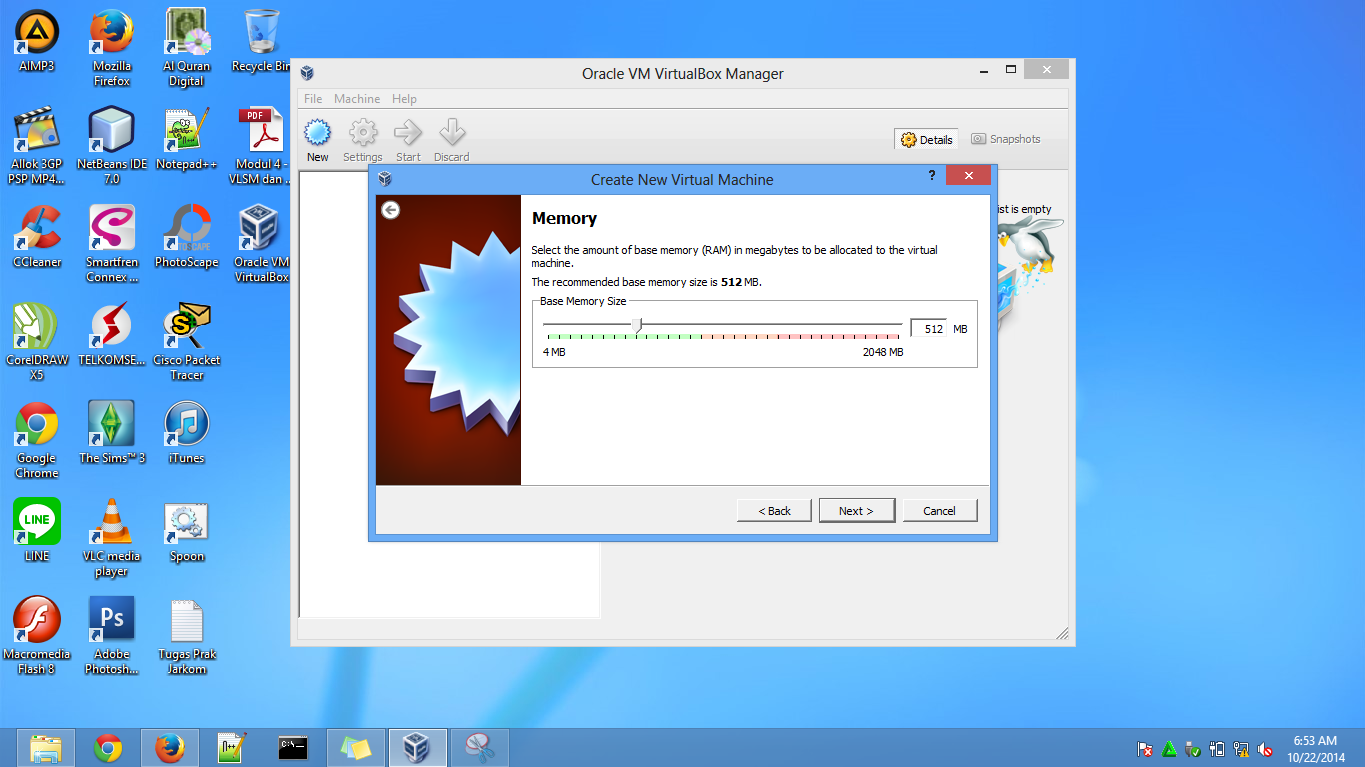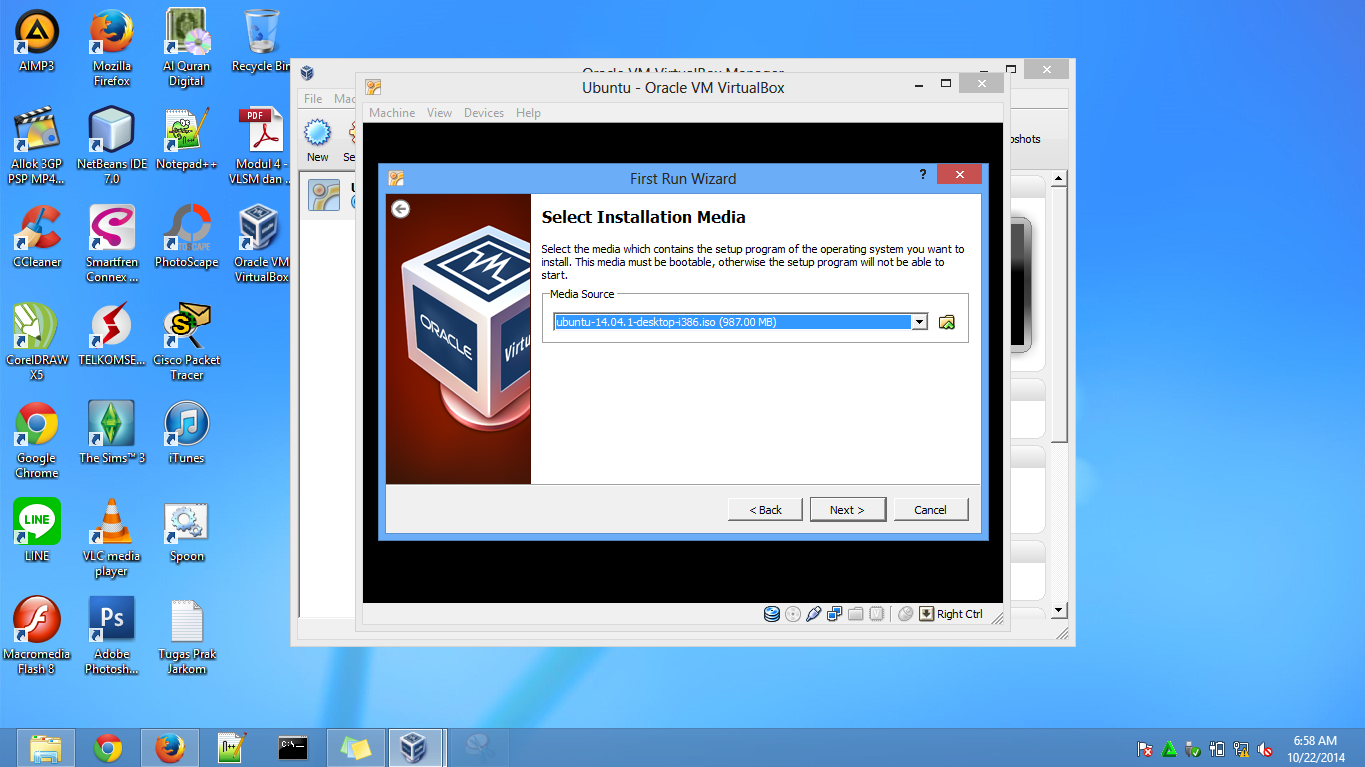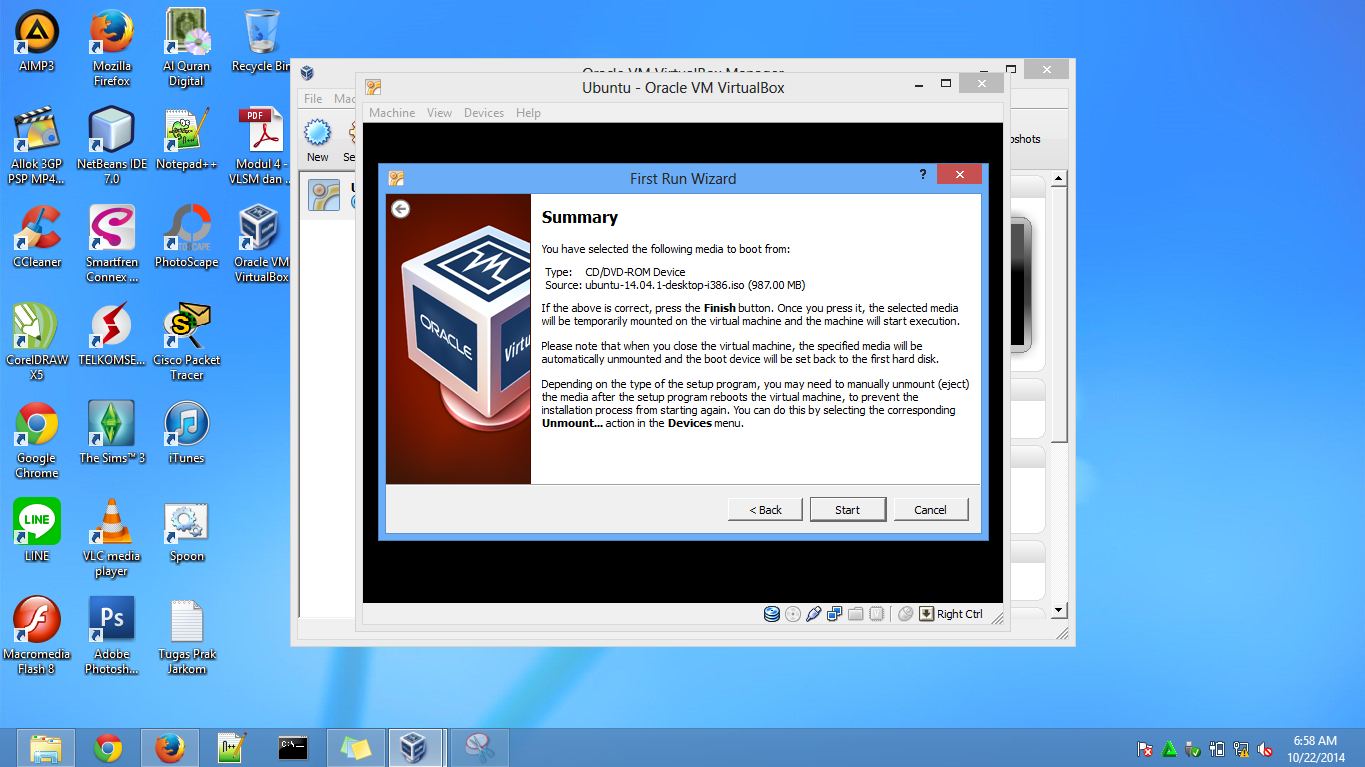Basic Terminal Shortcuts
CTRL L = Clear the terminal
CTRL D = Logout
CTRL A = Cursor to start of line
CTRL E = Cursor to the end of line
CTRL U = Delete left of the cursor
CTRL K = Delete right of the cursor
CTRL W = Delete word on the left
CTRL Y = Paste (after CTRL U, K or W)
CTRL R = Reverse search history
CTRL Z = Stops the current command
SHIFT Page Up/Down = Go Up/Down the terminal
TAB = Auto completion of file or command
!! = Repeat last command
Basic Terminal Navigation
ls -a = list all files and folders
ls <folderName> = list files in folde
ls -lh = Detailed list, Human readable
ls -l *.jpg = list jpeg files only
ls -lh <fileName> = Result for file only
cd <folderName> = change directory
if folder name has spaces use “ “
cd / = go to root
cd .. = go up one folder, tip: ../../../
du -h: Disk usage of folders, human readable
du -ah: “ “ “ files & folders, Human readable
du -sh: only show disc usage of folders
pwd = print working directory
man <command> = shows manual (RTFM)
Basic File Manipulation
cat <fileName> = show content of file (less, more)
head = from the top
-n <#oflines> <fileName>
tail = from the bottom
-n <#oflines> <fileName>
mkdir = create new folder
mkdir myStuff ..
mkdir myStuff/pictures/ ..
cp image.jpg newimage.jpg = copy and rename a file
cp image.jpg <folderName>/ = copy to folder
cp image.jpg folder/sameImageNewName.jpg
cp -R stuff otherStuff = copy and rename a folder
cp *.txt stuff/ = copy all of *<file type> to folder
mv file.txt Documents/ = move file to a folder
mv <folderName> <folderName2> = move folder in folder
mv filename.txt filename2.txt = rename file
mv <fileName> stuff/newfileName
mv <folderName>/ .. = move folder up in hierarchy
rm <fileName> .. = delete file (s)
rm -i <fileName> .. = ask for confirmation each file
rm -f <fileName> = force deletion of a file
rm -r <foldername>/ = delete folder
touch <fileName> = create or update a file
ln file1 file2 = physical link
ln -s file1 file2 = symbolic link
Researching Files
The slow method (sometimes very slow):
locate <text> = search the content of all the files
locate <fileName> = search for a file
sudo updatedb = update database of files
find = the best file search tool (fast)
find -name “<fileName>”
find -name “text” = search for files who start with the word text
find -name “*text” = “ “ “ “ end “ “ “ “
Advanced Search:
Search from file Size (in ~)
find ~ -size +10M = search files bigger than.. (M,K,G)
Search from last access
find -name “<filetype>” -atime -5
('-' = less than, '+' = more than and nothing = exactly)
Search only files or directory’s
find -type d --> ex: find /var/log -name "syslog" -type d
find -type f = files
More info: man find, man locate
Extract, sort and filter data
grep <someText> <fileName> = search for text in file
-i = Doesn't consider uppercase words
-I = exclude binary files
grep -r <text> <folderName>/ = search for file names with occurrence of the text
With regular expressions:
grep -E ^<text> <fileName> = search start of lines with the word text
grep -E <0-4> <fileName> =shows lines containing numbers 0-4
grep -E <a-zA-Z> <fileName> = retrieve all lines with alphabetical letters
sort = sort the content of files
sort <fileName> = sort alphabetically
sort -o <file> <outputFile> = write result to a file
sort -r <fileName> = sort in reverse
sort -R <fileName> = sort randomly
sort -n <fileName> = sort numbers
wc = word count
wc <fileName> = nbr of line, nbr of words, byte size -l (lines), -w (words), -c (byte size), -m (number of characters)
cut = cut a part of a file
-c --> ex: cut -c 2-5 names.txt (cut the characters 2 to 5 of each line)
-d (delimiter) (-d & -f good for .csv files)
-f (# of field to cut)
more info: man cut, man sort, man grep
Time settings
date = view & modify time (on your computer)
View:
date “+%H” --> If it's 9 am, then it will show 09 -r
date “+%H:%M:%Ss” = (hours, minutes, seconds)
%Y = years
Modify:
MMDDhhmmYYYY
Month | Day | Hours | Minutes | Year
sudo date 031423421997 = March 14th 1997, 23:42
Execute programs at another time
use 'at' to execute programs in the future
Step 1, write in the terminal: at <timeOfExecution> ENTER
ex --> at 16:45 or at 13:43 7/23/11 (to be more precise)
or after a certain delay:
at now +5 minutes (hours,days, weeks, months, years)
Step 2: <ENTER COMMAND> ENTER
repeat step 2 as many times you need
Step 3: CTRL D to close input
atq = show a list of jobs waiting to be executed
atrm = delete a job n°<x>
ex (delete job #42) --> atrm 42
sleep = pause between commands
with ';' you can chain commands, ex: touch file; rm file you can make a pause between commands (minutes, hours, days)
ex --> touch file; sleep 10; rm file <-- 10 seconds
crontab = execute a command regularly
-e = modify the crontab
-l = view current crontab
-r = delete you crontab
In crontab the syntax is
<Minutes> <Hours> <Day of month> <Day of week (0-6, 0 = Sunday)> <COMMAND>
ex, create the file movies.txt every day at 15:47:
47 15 * * * touch /home/bob/movies.txt
* * * * * --> every minute
at 5:30 in the morning, from the 1st to 15th each month:
30 5 1-15 * *
at midnight on Mondays, Wednesdays and Thursdays:
0 0 * * 1,3,4
every two hours:
0 */2 * * *
every 10 minutes Monday to Friday:
*/10 * * * 1-5
Execute programs in the background
Add a '&' at the end of a command
ex --> cp bigMovieFile.mp4 &
nohup: ignores the HUP signal when closing the console
(process will still run if the terminal is closed)
ex --> nohup cp bigMovieFile.mp4
jobs = know what is running in the background
fg = put a background process to foreground
ex: fg (process 1), f%2 (process 2) f%3, ...
Process Management
w = who is logged on and what they are doing
tload = graphic representation of system load average (quit with CTRL C)
ps = Static process list
-ef --> ex: ps -ef | less
-ejH --> show process hierarchy
-u --> process's from current user
Dynamic process list
While in top:
• q to close top
• h to show the help
• k to kill a process
CTRL C to top a current terminal process
kill = kill a process
You need the PID # of the process
ps -u <AccountName> | grep <Application>
Then
kill <PID> .. .. ..
kill -9 <PID> = violent kill
killall = kill multiple process's
ex --> killall locate
extras:
sudo halt <-- to close computer
sudo reboot <-- to reboot
Create and modify user accounts
sudo adduser bob = root creates new user
sudo passwd <AccountName> = change a user's password
sudo deluser <AccountName> = delete an account
addgroup friends = create a new user group
delgroup friends = delete a user group
usermod -g friends <Account> = add user to a group
usermod -g bob boby = change account name
usermod -aG friends bob = add groups to a user without loosing the ones he's already in
File Permissions
chown = change the owner of a file. ex --> chown bob hello.txt
chown user:bob report.txt = changes the user owning report.txt to 'user' and the group owning it to 'bob'
-R = recursively affect all the sub folders. ex --> chown -R bob:bob /home/Daniel
chmod = modify user access/permission – simple way
u = user
g = group
o = other
d = directory (if element is a directory)
l = link (if element is a file link)
r = read (read permissions)
w = write (write permissions)
x = eXecute (only useful for scripts and programs)
'+' means add a right
'-' means delete a right
'=' means affect a right
ex --> chmod g+w someFile.txt (add to current group the right to modify someFile.txt)
more info: man chmod
Flow redirection
Redirect results of commands:
'>' at the end of a command to redirect the result to a file. ex --> ps -ejH > process.txt
'>>' to redirect the result to the end of a file
Redirect errors:
'2>' at the end of the command to redirect the result to a file. ex --> cut -d , -f 1 file.csv > file 2> errors.log
'2>&1' to redirect the errors the same way as the standard output
Read progressively from the keyboard
<Command> << <wordToTerminateInput>
ex --> sort << END <-- This can be anything you want
> Hello
> Alex
> Cinema
> Game
> Code
> Ubuntu
> END
terminal output:
Alex
Cinema
Game
Code
Ubuntu
Another example --> wc -m << END
Chain commands
'|' at the end of a command to enter another one. ex --> du | sort -nr | less
Archive and compress data
Archive and compress data the long way:
Step 1, put all the files you want to compress in the same folder: ex --> mv *.txt folder/
Step 2, Create the tar file:
tar -cvf my_archive.tar folder/
-c : creates a .tar archive
-v : tells you what is happening (verbose)
-f : assembles the archive into one file
Step 3.1, create gzip file (most current):
gzip my_archive.tar
to decompress: gunzip my_archive.tar.gz
Step 3.2, or create a bzip2 file (more powerful but slow):
bzip2 my_archive.tar
to decompress: bunzip2 my_archive.tar.bz2
step 4, to decompress the .tar file:
tar -xvf archive.tar archive.tar
Archive and compress data the fast way:
gzip: tar -zcvf my_archive.tar.gz folder/
decompress: tar -zcvf my_archive.tar.gz Documents/
bzip2: tar -jcvf my_archive.tar.gz folder/
decompress: tar -jxvf archive.tar.bz2 Documents/
Show the content of .tar, .gz or .bz2 without decompressing it:
gzip:
gzip -ztf archive.tar.gz
bzip2:
bzip2 -jtf archive.tar.bz2
tar:
tar -tf archive.tar
tar extra:
tar -rvf archive.tar file.txt = add a file to the .tar
You can also directly compress a single file and view the file without decompressing:
Step 1, use gzip or bzip2 to compress the file:
gzip numbers.txt
Step 2, view the file without decompressing it:
zcat = view the entire file in the console (same as cat)
zmore = view one screen at a time the content of the file (same as more)
zless = view one line of the file at a time (same as less)
Installing software
When software is available in the repositories:
sudo apt-get install <nameOfSoftware>
ex--> sudo apt-get install aptitude
If you download it from the Internets in .gz format (or bz2) - “Compiling from source”
Step 1, create a folder to place the file:
mkdir /home/username/src <-- then cd to it
Step 2, with 'ls' verify that the file is there
(if not, mv ../file.tar.gz /home/username/src/)
Step 3, decompress the file (if .zip: unzip <file>)
Step 4, use 'ls', you should see a new directory
Step 5, cd to the new directory
Step 6.1, use ls to verify you have an INSTALL file, then: more INSTALL
If you don't have an INSTALL file:
Step 6.2, execute ./configure <-- creates a makefile
Step 6.2.1, run make <-- builds application binaries
Step 6.2.2 : switch to root --> su
Step 6.2.3 : make install <-- installs the software
Step 7, read the readme file
Reference
http://cli.learncodethehardway.org/bash_cheat_sheet.pdf
Thursday, October 23, 2014
Linux Bash Shell Cheat Sheet
Wednesday, October 22, 2014
Install Ubuntu Dengan Virtual Box
Virtual Box adalah software yang digunakan untuk membuat virtual komputer, sehingga memungkinkan kita bisa menginstall lebih dari satu OS dalam komputer tanpa menjadikannya menjadi dual boot.
Langkah-langkah untuk menginstall OS di Virtual Box adalah sebagai berikut:
1. Buka aplikasi Virtual Box yang sebelumnya sudah di install lalu klik New.
2. Muncul dialog box sebagai berikut, klik Next.
3. Isi text box nama virtual machine dan pilih OS yang diinginkan lalu klik Next.
4. Tentukan besar RAM untuk Virtual Box nya.
5. Pilih Create New Harddisk
6. Pilih File Type VDI.
7. Pilih Dynamically allocated agar virtual disk file bisa diubah lalu klik Next.
8. Tentukan besar ukuran file.
9. Klik Create.
10. Klik Create.
11. Klik Start.
12. Klik Next.
13. Pilih media installasi.
14. Klik Start.
15. Tunggu beberapa saat.
16. Pilih Install Ubuntu.
17. Pilih tipe install yang diinginkan.
18. Klik New Partition Table
19. Pilih Continue.
20. Tentukan partisi sebagai berikut:
21. Jika sudah, klik Install Now
22. Tentukan zona waktu dan pilih layout keyboard yang diinginkan.
23. Isi Username dan Password lalu klik Continue.
24. Tunggu sampai proses Install selesai.
25. Jika sudah selesai Restart PC.
26. Ini tampilan Desktop Ubuntu di Virtual Box.
Langkah-langkah untuk menginstall OS di Virtual Box adalah sebagai berikut:
1. Buka aplikasi Virtual Box yang sebelumnya sudah di install lalu klik New.
2. Muncul dialog box sebagai berikut, klik Next.
3. Isi text box nama virtual machine dan pilih OS yang diinginkan lalu klik Next.
4. Tentukan besar RAM untuk Virtual Box nya.
5. Pilih Create New Harddisk
6. Pilih File Type VDI.
7. Pilih Dynamically allocated agar virtual disk file bisa diubah lalu klik Next.
8. Tentukan besar ukuran file.
9. Klik Create.
10. Klik Create.
11. Klik Start.
12. Klik Next.
13. Pilih media installasi.
14. Klik Start.
15. Tunggu beberapa saat.
16. Pilih Install Ubuntu.
17. Pilih tipe install yang diinginkan.
18. Klik New Partition Table
19. Pilih Continue.
20. Tentukan partisi sebagai berikut:
21. Jika sudah, klik Install Now
22. Tentukan zona waktu dan pilih layout keyboard yang diinginkan.
23. Isi Username dan Password lalu klik Continue.
24. Tunggu sampai proses Install selesai.
25. Jika sudah selesai Restart PC.
26. Ini tampilan Desktop Ubuntu di Virtual Box.
Pilih
Dynamically alocated sehingga ukuran virtual disk file bisa
diubah – ubah, jika ingin tetap pilih fixed size. Kemudian klik next. -
See more at:
file:///C:/Users/ghita%20marshelina/Downloads/Cara%20Atau%20Langkah-Langkah%20Install%20Linux%20dengan%20Virtualbox%20_%20Pentium%20Blog.htm#sthash.EpbU1SZ5.dpuf
Virtualbox
adalah salah satu software yang
digunakan untuk membuat virtual komputer, sehingga dimungkinkan kita
bisa menginstall lebih dari 1 OS dalam 1 komputer. - See more at:
file:///C:/Users/ghita%20marshelina/Downloads/Cara%20Atau%20Langkah-Langkah%20Install%20Linux%20dengan%20Virtualbox%20_%20Pentium%20Blog.htm#sthash.EpbU1SZ5.dpufV
Virtualbox
adalah salah satu software yang
digunakan untuk membuat virtual komputer, sehingga dimungkinkan kita
bisa menginstall lebih dari 1 OS dalam 1 komputer. - See more at:
file:///C:/Users/ghita%20marshelina/Downloads/Cara%20Atau%20Langkah-Langkah%20Install%20Linux%20dengan%20Virtualbox%20_%20Pentium%20Blog.htm#sthash.EpbU1SZ5.dpuf
Virtualbox
adalah salah satu software yang
digunakan untuk membuat virtual komputer, sehingga dimungkinkan kita
bisa menginstall lebih dari 1 OS dalam 1 komputer. - See more at:
file:///C:/Users/ghita%20marshelina/Downloads/Cara%20Atau%20Langkah-Langkah%20Install%20Linux%20dengan%20Virtualbox%20_%20Pentium%20Blog.htm#sthash.EpbU1SZ5.dpuf
Virtualbox
adalah salah satu software yang
digunakan untuk membuat virtual komputer, sehingga dimungkinkan kita
bisa menginstall lebih dari 1 OS dalam 1 komputer. - See more at:
file:///C:/Users/ghita%20marshelina/Downloads/Cara%20Atau%20Langkah-Langkah%20Install%20Linux%20dengan%20Virtualbox%20_%20Pentium%20Blog.htm#sthash.EpbU1SZ5.dpuf
Virtualbox
adalah salah satu software yang
digunakan untuk membuat virtual komputer, sehingga dimungkinkan kita
bisa menginstall lebih dari 1 OS dalam 1 komputer. - See more at:
file:///C:/Users/ghita%20marshelina/Downloads/Cara%20Atau%20Langkah-Langkah%20Install%20Linux%20dengan%20Virtualbox%20_%20Pentium%20Blog.htm#sthash.EpbU1SZ5.dpuf
Virtualbox
adalah salah satu software yang
digunakan untuk membuat virtual komputer, sehingga dimungkinkan kita
bisa menginstall lebih dari 1 OS dalam 1 komputer. - See more at:
file:///C:/Users/ghita%20marshelina/Downloads/Cara%20Atau%20Langkah-Langkah%20Install%20Linux%20dengan%20Virtualbox%20_%20Pentium%20Blog.htm#sthash.EpbU1SZ5.dpuf
Labels:
Ilmu Komputer,
Install,
Linux,
Sistem Operasi,
Ubuntu,
Universitas Pendidikan Indonesia,
Virtual Box
Thursday, October 9, 2014
Bluemix by IBM
IBM adalah perusahaan yang bergerak di biang teknologi sejak 103 tahun yang lalu. Sedangkan di Indonesia baru berumur 75 tahun dengan pelanggan pertama yaitu PT. KAI.
IBM juga mengembangkan Cloud Computing, yaitu metoda komputasi di mana kapabilitas terkait teknologi informasi disajikan sebagai suatu layanan sehingga pengguna dapat mengaksesnya lewat internet.
Layanan yang terdapat pada Cloud Computing ada 3, yaitu:
1. Infrastructure as a Service (IaaS)
Menyediakan code, data, runtime, middleware, OS. Produk dari IBM yaitu SoftLayer dengan salah satu penggunanya adalah Path.
2. Platform as a Service (PaaS)
Menyediakan code dan data. Produk dari IBM yaitu Bluemix.
3. Software as a Service (SaaS)
Vendor memanajemen di cloud yaitu applications, data, runtime, middleware, O/S, virtualization, servers, storage dan networking.
Kenapa menggunakan Bluemix?
1. Safe money and time
2. Continuously deliver
Kelebihannya?
1. Support semua bahasa pemrograman
2. Coding via online atau outline (dengan sublime, eclipse, atau dngan cloud foundry command line)
3. Bisa memonitor aplikasi
4. Ada tools untuk melindungi aplikasi
Cara menggunakannya:
1. Sign Up di http://www.bluemix.net
2. Install Cloud Foundry
3. Log In ke Bluemix dengan menggunakan Cloud Foundry command line
4. Install runtime (jika diperlukan)
4. Develop project
Labels:
Bluemix,
Cloud Computing,
IBM,
Ilmu Komputer,
Jaringan Komputer,
Tugas Resume,
Universitas Pendidikan Indonesia
Subscribe to:
Posts (Atom)






























